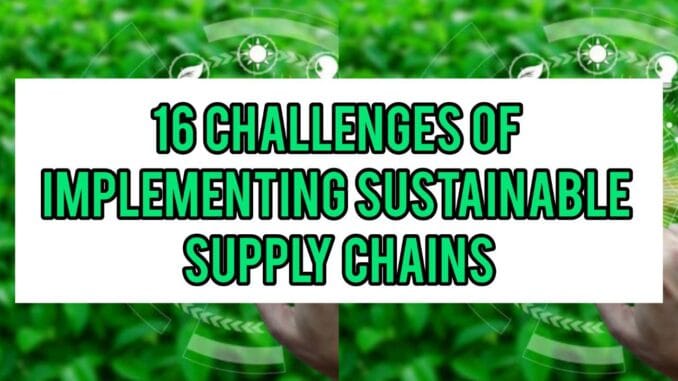
Imagine ordering a pair of shoes online and knowing every step—from the cotton fields where the laces grew to the final delivery—protected people and planet. That’s the promise of sustainable supply chains. In a world where consumers demand ethical practices and regulators tighten environmental rules, companies scramble to transform complex global networks of suppliers, manufacturers, and distributors. Yet behind every green claim lies a maze of challenges. In this article, we’ll dive deep into the sixteen biggest hurdles companies face when greening their supply chains—and explore everything you need to know to overcome them.
1. Defining Clear Sustainability Goals
Many companies start with a vague idea of “going green,” but lack concrete targets. How much carbon do you actually want to cut? Which human-rights standards matter most? Without SMART goals—Specific, Measurable, Attainable, Relevant, Time-bound—efforts drift. It’s like setting off on a road trip without a map. A clear destination and milestones keep everyone on track.
Setting SMART Objectives
Begin by benchmarking current footprints, then define precise targets—say, a 30% reduction in Scope 3 emissions over five years. Assign accountability, tie rewards to progress, and update goals as conditions evolve.
2. Engaging Complex Global Supplier Networks
Supply chains often span dozens of countries and thousands of tiers. A single product may source raw materials from Africa, parts from Asia, assemble in Latin America, and ship worldwide. Tracking sustainability practices across every link is daunting.
Building Trust and Collaboration
Companies must move beyond audits to partnerships: hosting supplier workshops, sharing best practices, and investing in capacity building. Transparency platforms and blockchain solutions can help trace products end-to-end.
3. Lack of Standardized Metrics and Reporting
Without universal metrics, every organization measures sustainability differently. One may track energy use per unit produced, another focuses on water consumption per kilogram of ingredient. That inconsistency hampers comparisons and collective action.
Adopting Industry Frameworks
Frameworks like the Global Reporting Initiative (GRI), CDP, and Science Based Targets initiative (SBTi) offer standardized indicators. Aligning with these frameworks ensures uniformity and credibility in reporting.
4. Data Collection and Quality Issues
Even with metrics agreed upon, gathering accurate data is a struggle. Suppliers may lack measuring tools, record-keeping systems, or the motivation to share sensitive data.
Implementing Digital Tools
IoT sensors, cloud-based dashboards, and mobile apps empower suppliers to input data in real time. Yet technology investment must be paired with training and incentives to ensure data integrity.
5. Financial Constraints and ROI Uncertainty
Transitioning to sustainable materials or clean energy often requires upfront capital. For many, the return on investment feels distant compared to short-term profit pressures.
Leveraging Green Financing
Sustainability-linked loans, green bonds, and government grants can offset capital costs. Demonstrating clear business cases—like energy savings or reduced waste disposal fees—helps win CFO buy-in.
6. Regulatory Complexity Across Jurisdictions
Global supply chains cross multiple legal environments. Environmental laws, labor standards, and import regulations vary widely, forcing companies to juggle conflicting requirements.
Navigating the Regulatory Maze
Dedicated compliance teams, legal partnerships, and global policy monitoring tools help firms stay ahead. Proactive engagement with policymakers can even shape more consistent regulations.
7. Supplier Resistance to Change
Many suppliers operate on razor-thin margins. They worry that new sustainability requirements will drive up their costs or complicate operations.
Incentivizing Sustainable Practices
Offer volume guarantees, technical support, or co-funding for cleaner machinery. Recognize and reward top-performing suppliers through awards or preferred-supplier status.
8. Balancing Quality, Cost, and Sustainability
A sustainable raw material might be pricier or less consistent in quality than conventional alternatives. Companies fear losing market share if costs climb or products vary.
Adopting a Total-Cost-of-Ownership Mindset
Shift focus from upfront price to long-term value, including waste reduction, brand reputation, and regulatory compliance. Test sustainable inputs in smaller product lines before scaling up.
9. Technology Integration Challenges
Digital platforms for traceability, emissions tracking, and supplier engagement promise efficiency but require seamless integration with legacy enterprise resource planning (ERP) systems.
Phased Implementation and Pilots
Start with pilot programs in one region or product category. Gather feedback, refine integration processes, and then roll out globally. This incremental approach minimizes disruption.
10. Cultural and Organizational Barriers
Sustainability often resides in a silo—handled by a CSR or ESG team—rather than woven into procurement, logistics, and product development.
Embedding Sustainability Into Corporate DNA
Cultivate cross-functional teams, integrate sustainability KPIs into performance reviews, and secure executive sponsorship. When every department owns part of the sustainability agenda, change accelerates.
11. Managing Downstream Impacts and End-of-Life
Designing products for recyclability or reuse demands rethinking packaging, materials, and reverse logistics. Many companies struggle to establish take-back programs or circular loops.
Developing Circular Economy Models
Partner with recycling firms and logistics providers to create convenient return channels. Incorporate modular design so components can be refurbished or remanufactured.
12. Ensuring Ethical Labor Practices
Beyond environmental issues, sustainable supply chains must respect human rights—from fair wages to safe working conditions. Verifying labor practices at every tier, especially in hidden sub-suppliers, is a critical challenge.
Strengthening Social Audits and Remediation
Combine third-party audits with worker-empowerment tools—anonymous hotlines, mobile surveys, and local NGOs—to capture real-time feedback. Develop remediation plans and track progress.
13. Tackling Greenwashing Risks
In the rush to claim “sustainable,” some firms overstate progress or use misleading labels, eroding consumer trust and inviting backlash.
Maintaining Transparency and Accountability
Publish detailed sustainability reports, undergo external verification, and avoid vague marketing claims. Honest storytelling, with both successes and setbacks, builds credibility.
14. Supply Chain Disruptions and Resilience
Climate change, pandemics, and geopolitical tensions can cripple supply routes. A focus on “just-in-time” efficiency often leaves no slack for shocks.
Building Flexibility and Redundancy
Develop multiple supplier sources, hold strategic safety stocks of critical materials, and invest in predictive analytics to foresee disruptions. Resilient supply chains adapt rather than collapse.
15. Consumer Awareness and Demand Variability
While some customers clamor for sustainable products, others remain indifferent or unwilling to pay premiums. This mixed demand complicates forecasting and product planning.
Educating and Engaging Customers
Transparency tools—like QR codes revealing a product’s carbon footprint—help consumers make informed choices. Story-driven marketing highlights the human and environmental impact, driving demand for sustainable options.
16. Measuring Impact and Continuous Improvement
Sustainability is not a one-time project but a journey. Companies need feedback loops and mechanisms for ongoing learning, yet few have robust processes in place.
Establishing Continuous Improvement Cycles
Implement Plan-Do-Check-Act (PDCA) cycles: pilot sustainability initiatives, measure outcomes, refine strategies, and scale. Regularly revisit goals to stay aligned with evolving best practices and stakeholder expectations.
Strategies to Overcome These Challenges
Effectively tackling these sixteen hurdles demands an integrated approach. Leadership commitment, cross-functional collaboration, and stakeholder engagement underpin success. Digital tools—from blockchain traceability to AI-driven risk analytics—provide visibility and predictive power. Financial innovations unlock capital, while partnerships with NGOs, industry consortia, and governments amplify impact. By embedding sustainability into core business strategy, companies turn supply chain challenges into competitive advantages.
The Business Case for Sustainable Supply Chains
Embracing sustainability strengthens brand reputation, attracts talent, and meets investor expectations. It reduces regulatory risks, cuts costs through efficiency gains, and fuels innovation. In increasingly green-minded markets, companies that pioneer sustainable supply chains gain first-mover advantages and capture new customer segments.
Case Study: Apparel Industry Transformation
A global fashion brand faced backlash over water pollution in its dyeing processes. By investing in closed-loop water systems, working with eco-friendly dye suppliers, and training artisans in low-impact techniques, the company cut water use by 80% and reduced chemical waste by 90%. Their revamped supply chain now stands as a model for the industry.
Future Trends in Sustainable Supply Chains
Emerging technologies like digital twins, real-time emissions monitoring, and machine-learning–based risk forecasting will usher in unprecedented transparency and agility. As regulations converge globally and carbon pricing gains prominence, sustainable supply chains will shift from “nice to have” to business-critical. The companies that evolve early will set the pace for the next decade.
Conclusion
Implementing sustainable supply chains is certainly no walk in the park. From vague goal-setting and data hurdles to financing concerns and greenwashing pitfalls, the road is strewn with obstacles. Yet each challenge presents an opportunity: to innovate, collaborate, and build resilience. Companies that navigate this landscape with clarity, transparency, and persistence unlock immense value—for shareholders, communities, and the environment itself. By tackling these sixteen challenges head-on, organizations can transform supply chains into engines of sustainability and growth.
FAQs
How do I start defining sustainability goals for my supply chain?
Begin with a baseline assessment of current environmental and social impacts. Engage stakeholders—suppliers, customers, employees—to identify priorities, then set SMART targets aligned with industry frameworks like CDP or SBTi.
What’s the most effective way to encourage suppliers to adopt green practices?
Combine incentives—volume guarantees, technical support, co-financing—with capacity-building workshops. Recognize high performers publicly and develop long-term partnerships built on trust and shared value.
How can small businesses afford the upfront costs of green technologies?
Explore green financing options, such as sustainability-linked loans and government grants. Start with low-cost, high-impact measures—like energy-efficient lighting—and reinvest savings into larger initiatives over time.
Is blockchain really necessary for supply chain transparency?
While not mandatory, blockchain offers immutable, real-time traceability that can enhance trust. Alternatives include centralized disclosure platforms and third-party verification, which may suffice depending on your industry and scale.
How do I measure the success of my sustainable supply chain initiatives?
Track key performance indicators—GHG emissions, water use, waste diversion, labor standards compliance—against your baseline. Use both quantitative data and qualitative feedback from stakeholders, and review progress in regular PDCA cycles.

Paul is a seasoned ecologist with over ten years of professional experience in managing environmental resources and exploring the emerging field of space ecology. Throughout his career, he has contributed to sustainable ecosystem research and examined how ecological principles apply beyond Earth, particularly in space missions and extraterrestrial environments. His work bridges the gap between Earth-based conservation efforts and the future of human life in space, making him a valuable expert in both traditional and cutting-edge ecological studies.
Leave a Reply